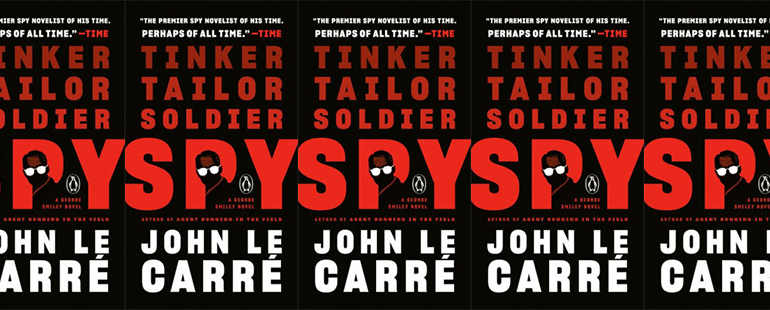Revisiting Tinker Tailor Soldier Spy

I’ve always felt that Tinker Tailor Soldier Spy rewired me in some fundamental way. When I first encountered John le Carré’s 1974 espionage masterpiece—in which a spy named George Smiley works to uncover a double agent in the upper echelons of the British secret service—I was a card-carrying, standard-issue wannabe writer. I had a literary studies degree under my belt, a few years’ experience reading books about books, and a grab bag of hand-me-down notions about what constituted “serious” literature.
As such, I was a little vexed by the intensity of my enthusiasm for it, especially my enthusiasm for its unputdownable and practically diamond-hewn plot. My excitement threw me for a loop. Isn’t a plot-driven book supposed to be a lesser art form than, say, a high-modernist novel of ideas? (I’d written a very eggheaded thesis in college about Robert Musil’s Man Without Qualities.) Isn’t a spy novel with a straightforward genre narrative indistinguishable from—gasp!—mere entertainment? Here was a book whose chief appeal seemed to lie in its story, in the technical wizardry of its plot, and yet I was obsessed with it. The evening I finished Tinker Tailor Soldier Spy at an ever-hastening gallop was one of the more enthralling reading experiences of my life.
I spent the next year reading practically every le Carré book I could get my hands on. There was plenty to wade through—he wrote twenty-five novels over the course of his career, from the formalistic genre exercises of the early 1960s to the celebrated George Smiley novels of his middle career, all the way to the underappreciated geopolitical thrillers of the 1990s and 2000s. In the whole oeuvre, there wasn’t a single book I didn’t admire. Working through le Carré’s output made me rethink the way I felt about things like plot and suspense, about the importance of creating and paying off narrative tension when communicating with the inner imaginations of readers. I felt I was taking a masterclass in plot mechanics—something my college studies had given me little ammunition for conceptualizing, yet something that proves quite useful if you find yourself identifying as a wannabe writer. (It’s an identity that, two unfinished novels later, I sadly retain.)
This was ten years ago. When le Carré died in December at the age of eighty-nine, I was drawn to revisit Tinker Tailor Soldier Spy for the first time since that year of total immersion. What I found was that, in viewing le Carré exclusively as a master technician, I’d gotten the book partially wrong. Its plotting was just as crystalline as I’d remembered, yet the enduring power of the novel didn’t lie in structure or its vast entertainment value, but in the lucidity of its politics and moral investments. At its heart, Tinker Tailor Soldier Spy is less a spy novel than it is an anti-imperialist jeremiad, an attempt to plumb and exhume the rot that had set in after centuries of British colonial misrule—a rot that would soon flourish into the crepuscular flower of neoliberal Thatcherism, something le Carré spent the rest of his career opposing.
The book hooks you with a simple mystery: who’s the mole in London Circus, and how has he managed to “pull the Circus inside out?” “The Circus,” in le Carré’s idiosyncratic nomenclature, means MI6, the Secret Intelligence Service of Great Britain—an institution for which le Carré worked as an undercover agent in Germany from 1960 to 1964. “Mole,” meaning double agent (“so-called because he burrows deep into the fabric of Western imperialism”), is likewise a le Carré coinage, but similar to “honey trap” it has so thoroughly penetrated the lexicon it often goes unattributed.
The hunt for the mole is carried out by George Smiley, an aging spymaster who’s been summoned out of retirement for this special task. Smiley is not exactly a charismatic leading man. He’s nowhere more undignified than when he’s introduced to readers at the beginning of the novel, “scuttling” along the pavement on a soggy day, drenched in rain and looking “small, podgy, and at best middle-aged.” He’s described at one point, when wiping his glasses on his tie during a cross-examination, as having “a soaked, naked look that was embarrassing to those who caught him at it.” Yet with his quiet fixity and unassuming intelligence, pursuing lengthy interrogation after lengthy interrogation, he steadfastly zeroes in on his target, and we can’t help but admire him for it.
Famously, George Smiley’s quest is inspired by a real-life mole who penetrated MI6 at the behest of the Russians, a man named Kim Philby. So many covers were blown by Philby’s double-crossing when he was exposed in 1963 and subsequently defected to Moscow that even a relatively small-time operative like le Carré was forced into early retirement. (At that point, le Carré could’ve started publishing books under his birth name, David Cornwell, which he’d been forbidden to use while actively employed as a spy, but he elected instead to continue writing under his chosen pseudonym for the remainder of his life.) In the aftermath of the Philby affair, a slew of high-ranking officials in MI6 were exposed as Russian moles, members of a circle retrospectively dubbed the “Cambridge Five.” Tinker Tailor Soldier Spy sometimes gets read as a straightforward historical treatment of Philby’s betrayal, a kind of coming to terms with why so many members of the espionage establishment wound up going rogue.
If that reading were accurate, however, the book is a strange way of coming to terms: it features almost no exploration of the inner psyche of a double agent. Instead, it seems to me that le Carré’s main interest in Tinker Tailor Soldier Spy is to process the guilt he felt about having worked for an institution—an extension of British empire—he would later come to hold in such thorough contempt. In his 2016 memoir The Pigeon Tunnel, he writes of spy agencies:
Nobody can do corporate rot more discreetly than the spies. Nobody does better mission creep. Nobody knows better how to create an image of mysterious omniscience and hide behind it. Nobody does a better job of pretending to be a cut above a public that has no choice but to pay top price for second-rate intelligence whose lure lies in the gothic secrecy of its procurement, rather than its intrinsic worth.
Le Carré, in other words, had nothing but scorn for the business of spying, and for the project of imperialism more generally that the spy establishment on both sides of the Cold War was created to uphold. (The resume of Ricki Tarr, the “scalphunter” who first clues Smiley in about the existence of a possible mole, gives a hint of the real remit of espionage agencies: Tarr’s career with the Circus began with “special operations in Kenya—or, in less sophisticated language, hunting Mau Mau for bounty.”) Le Carré’s anti-imperialism is not, naturally, a view shared by the characters of Tinker Tailor Soldier Spy, all of whom—including the mild-mannered George Smiley—are pensioned employees of Her Majesty’s Secret Service, engaged in a high-stakes and inarguably exciting game of chess with their counterparts across the Iron Curtain. The problem with the chess game, however, is that it’s predicated on ruining the lives of innocent people, and that victory only means further retrenchment and doubling down. “I don’t think it’s ever realized how much the industry stimulates its own inflation,” one colleague observes to Smiley.
As a consequence, if le Carré intends readers to see through to the rotten core of the espionage enterprise, he faces the difficult task of having to train them to see around his characters and their entertaining job. Ironically, the spy genre is a perfect vehicle for this. As readers absorbing the minutiae of George Smiley’s hunt—the grinding process of interview after interview, of Smiley digging deeper into the pasts of his four prime suspects (assigned the codenames Tinker, Tailor, Soldier, and Sailor)—what else are we doing but learning to see the world as a spy sees it, to pay attention to the shifting terrain of “human transgression and the many routes to betrayal?”
Le Carré instructs his readers how to be watchers and burrowers, connoisseurs of the telling gesture. As we tag along with Smiley, we examine the various suspects minutely, learning to notice things like how:
Sitting is an eloquent business; any actor will tell you that. We sit according to our natures. We sprawl and straddle, we rest like boxers between rounds, we fidget, perch, and uncross our legs, lose patience, lose endurance. Gerstmann did none of these things. His posture was finite and irreducible, his little jagged body was like a promontory of rock; he could have sat that way all day, without stirring a muscle.
I love the merging of the concrete and ambiguous in this description—a posture “finite and irreducible.” Somehow we know what this means. Or consider another of le Carré’s wonderfully spotlighted gestures, when an interlocutor of Smiley’s unconsciously reveals that he knows more about a subject of questioning than he cares to let on:
Max’s hands were resting on his knees. They were groomed and slender—all but the knuckles, which were very broad. Now, at the mention of Esterhase, he turned the palms slightly inwards and made a light cage of them as if he had caught a butterfly.
Eventually, as these sorts of tells accumulate, they prompt Smiley to unravel the mystery. But the task le Carré presents readers is different. Unlike a traditional whodunnit, we’re not being challenged to predict the outcome of the case. (A careful reader, in fact, will notice that Smiley already guesses the identity of the mole at the novel’s outset.) Instead, we’re dropped into a world we barely understand, and our job is to unpack how the individuals populating London Circus align themselves with power. How class and prestige serve to structure and deform social relations. More importantly, what qualities of personality might make someone resistant to the kinds of institutional rot that allow bad actors like Philby—and the coterie of power-hungry flatterers who facilitate his rise to power—to flourish.
Seeing the book this way clarifies why, all those years back, I’d experienced Tinker Tailor Soldier Spy as such a challenge to my half-baked l’art pour l’art convictions, and why I felt I needed to write differently in its aftermath. Le Carré intends the book to confront readers’ complacency. He weaponizes the spy genre as a tool for luring them in, then entraps them and makes them marinate in his pitiless moral vision. It’s a social novel in the guise of genre fiction, and, like all social novels, its métier is political critique. The substance of the critique becomes more explicit in le Carré’s later works—for example The Constant Gardener (2001), in which a crusading activist is murdered by a pharmaceutical company for trying to reveal its program of illegal testing on Kenyan subjects, or A Most Wanted Man (2008), in which an innocent Muslim teenager becomes a pawn in the machinations of competing intelligence services—but in Tinker Tailor Soldier Spy the marriage of plot and meaning, structure and signal, form and substance, is at its most subtle and complete.
There’s an image from le Carré’s 2016 memoir, published four years before his death, that has lingered with me in connection with this idea. The book is called The Pigeon Tunnel, and in the introduction, le Carré explains the meaning of his confusing title:
I was in my mid-teens when my father decided to take me on one of his gambling sprees to Monte Carlo. Close by the old casino stood the sporting club, and at its base lay a stretch of lawn and a shooting range looking out to sea. Under the lawn ran small, parallel tunnels that emerged in a row at the sea’s edge. Into them were inserted live pigeons that had been hatched and trapped on the casino roof. Their job was to flutter their way along the pitch-dark tunnel until they emerged in the Mediterranean sky as targets for well-lunched sporting gentlemen who were standing or lying in wait with their shotguns. Pigeons who were missed or merely winged then did what pigeons do. They returned to the place of their birth on the casino roof, where the same traps awaited them.
Le Carré claims there isn’t a single novel he’s written that didn’t, at one point or another, bear the working title The Pigeon Tunnel. It’s a somewhat baffling pronouncement. Who are these doomed pigeons supposed to be? The espionage services? Their surveillance targets? I prefer to think they’re the Anglo-American reading public, and at the end of the tunnel stands le Carré, blasting them in the face with the rotten truth.



